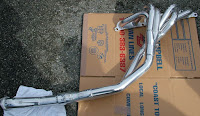General specifications:
- Bore: 83mm (3.27")
- Stroke: 85mm (3.35")
- Displacement: 2,759cc (164.8 cid)
- 1982:
145bhp 150ft/lbs
vacuum advanced distributor
square tooth timing belt
shallow oil pan
round intake runners
dual v-belt accessory drive
- 1983
TCCS added (Toyota Computer Controlled System)
electronic distibutor
- 1984 (some early automatics kept the 1983 engine)
160bhp 163ft/lbs
round tooth timing belt
deeper oil pan (on some later 84 cars)
D-shaped intake runners
7 rib serpentine accessory drive
- 1985/1986
deeper oil pan standard
round TPS
knock sensor
"6M" marked lower rear timing cover on later 85+ blocks
round TPS
knock sensor
"6M" marked lower rear timing cover on later 85+ blocks
multiple knock sensor bosses on later 85+ blocks
For MAXIMUM naturally aspirated power gains through computer management, you would want to use a standalone ECU and it's associated necessary sensors (MAF, IAT, cam/crank sensor, etc). This averages $1200ish USD give or take, and it is recommended to build your own engine harness. Megasquirt 2 and 3 are currently the popular choices. More information available through celicasupra.com forum search.
UPGRADES:
- EXHAUST:
The best improvement to naturally aspirated power output hands down is exhaust. A good header and larger exhaust piping allows the engine to breathe easier and you could expect to see gains of around 10-15hp at the wheels from a healthy engine.
Currently available header options are:
Out of Production Header searches: Tri-Mil, TRD, Doug Thorley (these might show up on eBay occasionally)
Currently available bolt on catback options:
- INTAKE
To replace the restrictive, and probably cracked, OEM intake tubing, you can either DIY a 3" pipe in the correct angles from the throttle body to the AFM, or purchase a ready to bolt on, CERAMIC COATED one from RaptorRacing HERE.
Many years ago a run of 1mm oversized stainless steel valves were produced. You may find these on eBay if you are lucky. There are none in production currently.
Performance camshafts also have been discontinued for years now. There used to be HKS, TRD and GUDE brand, with their being multiple grinds from HKS. You can, however, get regrinds through places like Delta cams.
Performance camshafts also have been discontinued for years now. There used to be HKS, TRD and GUDE brand, with their being multiple grinds from HKS. You can, however, get regrinds through places like Delta cams.
- Timing
- Engine Management
For MAXIMUM naturally aspirated power gains through computer management, you would want to use a standalone ECU and it's associated necessary sensors (MAF, IAT, cam/crank sensor, etc). This averages $1200ish USD give or take, and it is recommended to build your own engine harness. Megasquirt 2 and 3 are currently the popular choices. More information available through celicasupra.com forum search.
TO BE CONTINUED....................







